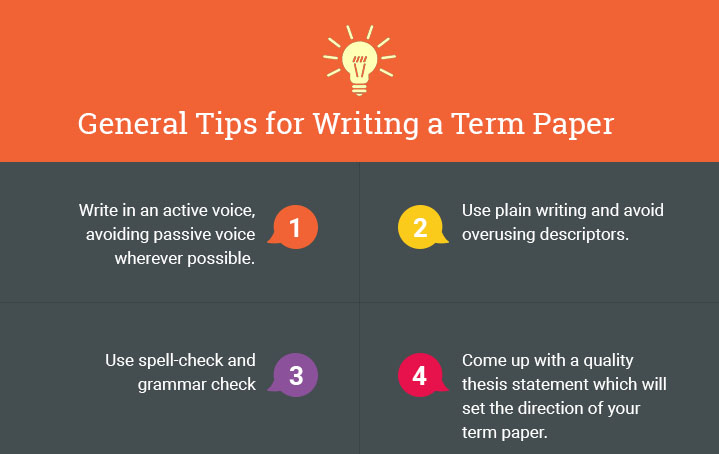
Are you freaking out about a term paper, essay, or research paper? You are not alone. Many students find academic writing assignments very intimidating. This is particularly true if the assignment is an unfamiliar one or involves an unfamiliar topic. Most modern K-12 writing is in the form of expository essays. Therefore, many college students, even those who did very well in their K-12 ELA courses, are freaked out by the idea of writing a term paper.
Don’t worry; we are here to help. In this easy how-to-guide, we will take you step-by-step through the term paper process. From telling you what a term paper is, to the nitty-gritty details involved in writing one, this guide will tell you everything you need to know about the term-paper process. As an added bonus, we have even included some popular term paper topics, to help you get started!

A term paper is a long essay or research paper, which is usually a substantial portion of a student’s grade. However, the length is not what makes a term paper a term paper. The “term” in term paper refers to the semester, or in some cases, multiple semesters of study in a course that the essay should reflect. Therefore, a term paper is a research essay that reflects what a student has learned over the course of the term, and applies that knowledge to a concept, idea, or event described in the paper.
Was that definition vague enough for you? Sorry about that, but the reality is that a term paper assignment from one course may look very different from a term paper assignment for another course. That is to be expected, since a term paper is ideally going to reflect the content and difficulty of the underlying course. Though not a general rule, you should expect term paper assignments to be similar to basic research paper assignments in lower level courses, but become more complex as you get into upper-level courses.
While the goal of your term paper is going to vary from course to course, there are some common traits for a strong research paper. Strong term papers do not just provide information; they provide information in a specific way that allows the reader to understand how that information is applicable to the topic being discussed:
First, a great term paper organizes the information that is presented in the paper. In addition to information that you have learned as part of your coursework, you are probably going to research and investigating other sources. You need to organized all of that material so that you can present it to the reader in a coherent manner. The reader cannot understand your analysis or determine whether your conclusion is valid if they cannot understand the underlying information. Therefore, you need to organize that information.
Next, it is not enough to present your readers with information, you have to take the next step and show them how that information goes together. Synthesize the information to show how seemingly disparate pieces of information all support the whole. Synthesizing may involve explaining those connections, but it may also involve additional research to support your connections.
Finally, you need to provide an analysis. In an analysis, you do more than present theories, facts, and evidence. You go a step beyond and examine what you have provided. Are the facts in dispute? Do the conclusions that others have drawn from those facts make logical sense? Are there questions of validity? If there are problems with any of your evidence, address them in your analysis or else your paper will appear weak.
While we have presented these three elements in an arrow-format, it is important to realize that this arrow may recur throughout your paper. Depending on how in-depth your term paper is, you may be discussing a number of different topics and sub-topics. Each of those topics and sub-topics will need to be organized, synthesized, and analyzed. The end result of your analysis may provide a piece of supporting evidence for your outline (discussed below), or it may provide you with your thesis statement, depending on the level of your analysis.
One of the biggest mistakes term paper writers can make is not getting the format or structure correct. While the importance of structure varies from school to school and even from professor to professor, incorrect structure can literally mean the difference between an A+ and a failing grade. Therefore, the first question to ask is what style your professor expects.
There are a number of different academic styles that dictate the rules for academic writing. MLA and APA are the styles that undergraduate students most frequently encounter, but you may also be asked to use Chicago, Turabian, BlueBook, IEEE, or a host of other styles, depending on your school and on the topic of your paper. Whatever style you are told to use, it is important that you use it.
Because most undergraduate papers will be in MLA or APA format, and the two formats have a number of similarities, we are going to use them as a background to discuss general term paper format or structure. If you have additional questions about the structure for a paper, please look at one of our in-depth style guidelines. If you are assigned a different writing style, please look at an in-depth style guideline for that format.
One of the first things to consider is font. Students often think that they can somehow sneak through guidelines by using a larger front to stretch their material to minimum page limit or a smaller font to bypass any page limits. Not only will this not work, but it will probably piss off your professor. Generally, unless otherwise instructed, assume that you will use a 12pt font. In addition, do not get fancy with your fonts. Times New Roman may seem like a boring choice to you, but it is easy-to-read. If you want to choose another font, clear it with your professor and makes sure it is also easy-to-read.
The second thing to consider is margins. Generally, a “new” document on a word processor program is going to have the default margins that you use for academic writing. These margins are usually 1-inch on the sides and on the top and the bottom. Just like messing with the font, you do not want to try to mess with the margins to make your material appear to meet an assignment’s guidelines. Just trust us when we tell you that your professor can tell the difference between an inch and two inches.
The set-up of your title page, how you will paginate your numbers, and whether you will include a running head in your header depend on the writing style assigned. Check out one of our handy style-guides for more information on style-specific formatting.
Finally, we can look at the format of your paper. There is no established format for term papers. You can style your term paper however you want to style it. However, there is an accepted format for academic writing that will not only be familiar to your professor, but will also help you establish your points and remain cohesive. We are going to call this format the five-paragraph essay, though a term paper is generally going to be longer than five paragraphs. That is no problem; the beauty of the five paragraph format is that it can shorter or longer than five paragraphs, and, in very long essays, may actually contain multiple different five-paragraph type sub-essays!
For most students, the five paragraph essay format is a familiar academic writing style. The order of the paragraphs is: introduction, supporting paragraphs or body of the essay, conclusion. The introduction serves as a preview for the rest of the essay; it introduces the topic, previews the supporting paragraphs, and states a thesis. Each supporting paragraph discusses a broad idea and them gives specific support for that broad idea. The conclusion is basically a restatement of the introduction.
Your thesis statement is critical to the success of your term paper. Your thesis statement summarizes the end-result of all of the analysis you have done on a topic. It is a one-or-two sentence statement that performs multiple functions: 1) letting the reader know your topic; 2) controlling the rest of your paper; and 3) stating your conclusions about the topic.
Your thesis statement is important because it helps separate your narrow topic from a broader topic. Let us say that your paper is about abortion. There are thousands of ways to approach that topic and if you do not limit yourself you will present a disorganized essay. Therefore, you want to have a fairly narrow thesis statement. Your thesis statement may be something like, “Contrary to modern-day belief, abortion was not considered taboo in Biblical times.” Then, you would need to provide support for that statement. This limits your paper by keeping you from going into modern arguments for or against choice. In other words, you can use your thesis statement as a litmus test for the rest of your paper. If material does not support your thesis statement, you either need to revise the thesis statement or eliminate that material!
In addition to the above general-rules for format, there are some basic guidelines for any type of academic writing:
1. Write in an active voice, avoiding passive voice wherever possible.
2. Use plain writing and avoid overusing descriptors.
3. Avoid contractions and slang.
4. Vary your sentence structure.
5. No run-on sentences!!!
6. Use simple punctuation.
7. Watch your verbs. Are you writing in an active voice? Are you keeping verb-tense consistent in your paper, except for when a switch in tense makes sense (such as when discussing a historical event)? Are you making sure your subjects and verbs agree?
8. Watch your pronoun usage. If you are discussing multiple characters or people, make sure it is very clear to the reader whom is being discussed at all times.
9. Use complete sentences.
10. Use spell-check and grammar check. While a professor may overlook a mistake that would not be caught by a work processing program’s spell-check or grammar-check function, turning in a paper with errors that could have been caught with a simple check can really impact your grade!
The basic outline for a term paper is going to be the same as one for a five-paragraph essay, but you are going to expand it to suit your needs. Instead of three points, you may have five or six points. In addition, to provide support for these points, you may need a paragraph to explain each point of supporting evidence.
I. Thesis statement
A. Point 1
B. Point 2
C. Point 3
II. Point 1
A. Supporting evidence 1
B. Supporting evidence 2
C. Supporting evidence 3
III. Point 2
A. Supporting evidence 1
B. Supporting evidence 2
C. Supporting evidence 3
IV. Point 3
A. Supporting evidence 1
B. Supporting evidence 2
C. Supporting evidence 3
V. Conclusion
A. Point 1
B. Point 2
C. Point 3
We like to plan our term paper outlines in a way that makes it super-easy to write a term paper, which means that we plan it down to the paragraph. If you will need more than two or three sentences to explain a piece of supporting evidence, then that supporting evidence needs its own paragraph. This is what we mean by the paper being broken down into multiple smaller papers, depending on the depth of your support and research.

How do you come up with a term paper topic? It really depends on the subject you are studying, the depth of your course, the expectations for your paper, and your own personal interests and preferences. Unless you have been warned that your professor has very rigid expectations, do not be afraid to think outside-of-the-box. However, keep in mind that if you are tackling an unusual topic, you may have a more difficult time supporting your conclusions than if you are handling a frequently-discussed topic.

The best way to come up with term paper topics is to sit down with your class notes and your school books, and brain storm about the topic. Let yourself think about some ideas and concepts that you found interesting during the course of your class. Write them down. Do not self-censor when you are brainstorming; let yourself think about any topic that might be of interest. Then, consider whether you can expand that topic into a term paper.
Popular topics for term papers include social issues, current events, and cultural issues, as well as classic works of literature and familiar themes in history. Here are a few topics you may want to consider for your term paper:
Abortion: Is the pro-life movement properly considered pro-life, or is it only actually pro-birth? Are there non-religious reasons to equate abortion to murder? Is denying abortion access to women who may not have willingly conceived similar to slavery? Does abortion have a racist impact?

Suicide: Is suicide selfish? Should the cause of death for suicides be considered homicide or depression? Do suicides tend to follow trends? Should suicidal idealizations ever be dismissed as a plea for attention? Should people be held legally responsible for encouraging another person to commit suicide?
Drugs: Should medicinal marijuana be legalized throughout the United States? Should recreational marijuana be legalized throughout the United States? Does use of legal drugs like alcohol and nicotine encourage use of illegal drugs? Does America’s drug policy treat addiction? What models are effective at treating addiction?

Race and Racism: What is privilege? Does race continue to impact society in modern-day America? Are affirmative-action policies for college admission fair or do they keep qualified applicants from obtaining a college education? What is the source of racism in the criminal justice system? Are movements like Black Lives Matter racist? Is the rise of hate-groups of real concern in modern-day America or are they fringe movements that only speak to a minority of people? Is anti-Muslim discrimination justified if it leads to a reduction in terrorist attacks? Is religious discrimination the same as racism? What role did racism play in the 2016 presidential election?
While a term paper is typically going to be longer than even a standard five-paragraph essay, we are including an example of a term paper on a current event topic: sexting and public figures. This example will briefly mention two public figures whose careers were impacted because of sexting behavior. You should be able to easily see how the paragraphs on each of these public figures could be fleshed-out to greatly expand the paper and how additional public figures could be included for a longer paper.
Sexting and Public Figures
Sexting, or sending sexually explicit messages via text or social media, is not necessarily a negative behavior. Couples may use sexting to keep a relationship spicy over long-distances, and users of hook-up aps like Tinder may use it to try to discover if a potential partner is interested. While there may be some reasonable guidelines for users to follow, such as not sending sexually explicit photos or messages unless they are requested, sexting has become an accepted form of communication. However, uninvited sexts are not just uncomfortable; they may be illegal. Despite that, a number of public figures have been caught up in their own sexting scandals.
Two of these people, Eric Bolling of Fox News and the politician Anthony Weiner used sexting in a predatory manner that resulted in criminal conviction for Weiner and currently has Bolling under investigation. This apparent disregard for potentially negative consequences has to make people wonder if these public-figures sext because they believe that they are invincible or because they enjoy the high-risk aspects of the behavior. At least in the case of Weiner and Bolling, the high-risk element of the behavior seems to be part of the appeal of sexting.
While Bolling has not faced any criminal charges for his alleged sexting behavior, he is under investigation for those allegations. According to his accusers, Bolling used sexts to sexually harass his coworkers at Fox News. This is clearly high-risk behavior. First, Fox News has faced a number of sexual harassment allegations, which has unearthed evidence of a sexual harassment-tolerant organization, making it more difficult for people to engage in that behavior at Fox without being revealed. Second, if the allegations that he sent sexually explicit photos to coworkers are true, Bolling provided undeniable evidence of his behavior, even in this high-risk atmosphere. As a result, it is reasonable to conclude that Bolling was motivated, at least in part, by the high-risk elements of the sexting behavior.
Anthony Weiner’s sexting history is even more alarming. Once a rising star in the Democratic Party, Weiner was plagued by multiple sexting-type scandals. In the most recent scandal, Weiner, a self-described sex addict, sent sexually explicit materials to an under-aged girl. However, this only occurred after other sexting scandals, including sending sexts via his public Twitter account. He continued to escalate the risk-taking behavior, but engaged in denials each time he was caught, suggesting that he enjoyed the high-risk elements of the sexting behavior.
While some public figures may engage in sexting for the same reasons as members of the general public, such as flirting, the fact that these images can be used against them means that sexts by public figures are probably never an example of good judgment. Because public figures are aware of the dangers that their behavior will be made public and used against them, sexting by public figures is, by its very nature, high-risk. Therefore, one cannot help but assume that sexting by public figures is motivated, at least in part, by the fact that it is a high-risk behavior.

Writing a term paper may seem like a very challenging prospect. This is not necessarily fair; if you give yourself ample time for the project, find the topic interesting, pay attention in class, and interact with your professor, term papers can actually be one of the most rewarding parts of your college education.
If you have not been one of those students, are struggling with a boring topic, have a time-crunch, or simply hate writing, we are here to help. Whether helping you with term paper topics, providing style guides, proof-reading and editing your term paper, or providing an example term paper for you, we have a wide range of services designed to make the term-paper process easier for students!

Comments